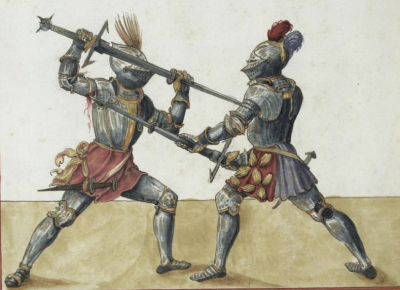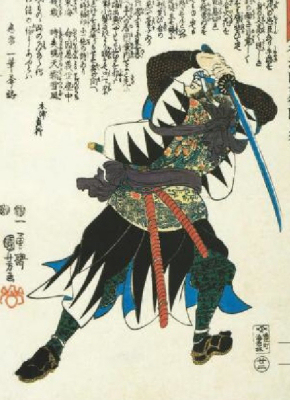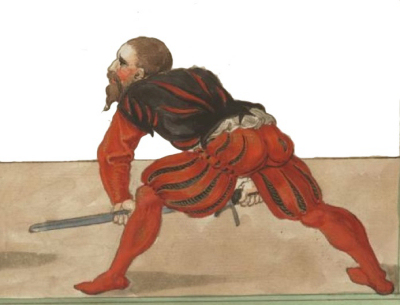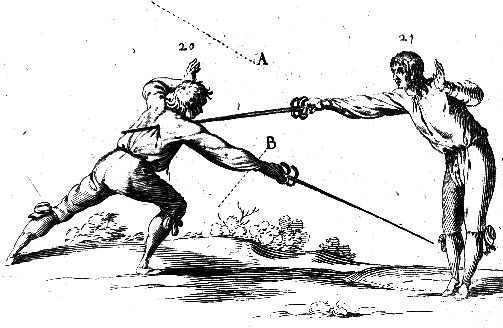Recounting
Experiences with a TV Documentary on Knight vs. Samurai
By
John Clements
ARMA Director
 Back
around 2007, a small television production company out of New York City
approached me about doing a cable television special based upon my popular
"knight versus
samurai" and "rapier
versus katana" articles. Such a project has long been a keen
interest of mine and I've given the subject a lot of serious thought.
After several weeks of discussion on what format the program should take,
they flew down to Atlanta for a day of filming. The crew took some b-roll
footage of us training, then conducted interviews with myself as well
as the noted historian of feudal Japan, Professor Karl Friday (himself
a longtime practitioner of budo). To make a long story short, despite
considerable efforts, after several months the producers ultimately dropped
the project. How come? ...They had difficulty finding an expert swordsman
from any noted school or teacher of classical kenjutsu who was willing
to participate. Back
around 2007, a small television production company out of New York City
approached me about doing a cable television special based upon my popular
"knight versus
samurai" and "rapier
versus katana" articles. Such a project has long been a keen
interest of mine and I've given the subject a lot of serious thought.
After several weeks of discussion on what format the program should take,
they flew down to Atlanta for a day of filming. The crew took some b-roll
footage of us training, then conducted interviews with myself as well
as the noted historian of feudal Japan, Professor Karl Friday (himself
a longtime practitioner of budo). To make a long story short, despite
considerable efforts, after several months the producers ultimately dropped
the project. How come? ...They had difficulty finding an expert swordsman
from any noted school or teacher of classical kenjutsu who was willing
to participate.
Why was that? Well, essentially, from what we gathered, not one
would
agree to enter an armored mock-combat session on camera
--sparring blunt
sword to blunt sword-- against a senior student of mine wearing
his 15th-century Gothic harness. Nor was anyone willing to also then do
the same unarmored
against me wielding my blunt rapier foyle. As soon as it was
described
that no wooden swords would be permitted, only historically
accurate training
blades, and that grappling and full-body targets would be
included as
well as thrusting, they all turned down the offer. Everyone
contacted
was more than willing to do mere side-by-side demonstrations
with us (useless
for the purposes of the program's premise), and they were all
ready to
do the overly familiar, standard routine displays of their own
sword art
with their own students. But cross-system free-play with actual
contact
was out of the question.
 Despite my consternation, I agreed to this with the intention that, once
we were all on set with weapons crossed, we would start slowly upping
the ante, forcing them on camera to either respond in true time and true
force or else simply get hit-- repeatedly. The producers agreed this would
be ideal for the candid and unchoreographed action shots the program needed.
But I suspect our potential co-stars assumed this is what would've eventually
happened because no agreement could ever be reached as to when, where,
and under what conditions it would all take place. I suppose it was a
matter of saving face. They had nothing to gain and everything to risk
from looking bad in such an encounter. After all, they would be representing
a school, a master, a reputation, and "all of Japanese martial culture,"
while we were just "amateurs" pretending with "broadswords
and foils" (...hard to blame them for such ignorance, given the mediocrity
out there that has long passed for our craft). But I like to think that
the real reason was that once they saw videos of us in action with our
federschwerts (clips which the producers in fact did provide),
the shock of our not being what they imagined was also a big factor. This
wasn't the first time I experienced such a thing, nor has it been the
last. Despite my consternation, I agreed to this with the intention that, once
we were all on set with weapons crossed, we would start slowly upping
the ante, forcing them on camera to either respond in true time and true
force or else simply get hit-- repeatedly. The producers agreed this would
be ideal for the candid and unchoreographed action shots the program needed.
But I suspect our potential co-stars assumed this is what would've eventually
happened because no agreement could ever be reached as to when, where,
and under what conditions it would all take place. I suppose it was a
matter of saving face. They had nothing to gain and everything to risk
from looking bad in such an encounter. After all, they would be representing
a school, a master, a reputation, and "all of Japanese martial culture,"
while we were just "amateurs" pretending with "broadswords
and foils" (...hard to blame them for such ignorance, given the mediocrity
out there that has long passed for our craft). But I like to think that
the real reason was that once they saw videos of us in action with our
federschwerts (clips which the producers in fact did provide),
the shock of our not being what they imagined was also a big factor. This
wasn't the first time I experienced such a thing, nor has it been the
last.
To
be sure, there were plenty of non-traditionalist practitioners from unaffiliated
and un-credentialed teachers of Japanese sword arts eager and enthusiastic
to participate. Many solicited us for the opportunity to earn some desperately
needed credibility. But that missed the point entirely. For a television
special investigating the differences in physicality, martiality, and
technicality of these historical warriors and their famous armaments,
we intentionally sought out legitimate representatives of established
schools who were, in fact, ethnically Japanese. We wanted fighters reflective
of their own forebears and the fighting craft they devised, instead of
some large Westerner representing some modified modern version altered
to their physique and temperament. If you are exploring the authentic
methods and equipment of a historical warrior then you damn well need
to represent their build and stature, not that of someone else's ancestors.
I was as uncompromising on this point as I was on the condition of safely
performing unrehearsed fighter-versus-fighter counter strikes in contact
at full speed using metal blades and accurate reproduction armors and
garb, not costumes.
 However, the only thing any traditional master contacted would agree
to, we were told, was artificially facing off in assorted counter-poses
--with the blades pressed one against the other in some half-ass watered-down
choreographed stage-combat fantasy. But they all had to be assured no
actual "un-programmed action" was to take place. They gave all
the same excuses for why this had to be: they didn't have blunt katanas,
they don't spar, they can't risk their expensive replica armor being scratched
rolling around on the ground, thrusting at their more exposed helmets
and armor is just too dangerous; target areas shouldn't include fingers
or feet because (unlike ours) their armor doesn't cover those areas; grappling
holds in armor would be too dangerous to employ; etc. In fact, the less
amateur and more qualified the representative, the more excuses we were
given for why their skills "only work for real" and not in "mock
practice" against those unfamiliar with them. Ahh... yes, of course.
How convenient. Sorry we barbarians did not appreciate this cosmic truth. However, the only thing any traditional master contacted would agree
to, we were told, was artificially facing off in assorted counter-poses
--with the blades pressed one against the other in some half-ass watered-down
choreographed stage-combat fantasy. But they all had to be assured no
actual "un-programmed action" was to take place. They gave all
the same excuses for why this had to be: they didn't have blunt katanas,
they don't spar, they can't risk their expensive replica armor being scratched
rolling around on the ground, thrusting at their more exposed helmets
and armor is just too dangerous; target areas shouldn't include fingers
or feet because (unlike ours) their armor doesn't cover those areas; grappling
holds in armor would be too dangerous to employ; etc. In fact, the less
amateur and more qualified the representative, the more excuses we were
given for why their skills "only work for real" and not in "mock
practice" against those unfamiliar with them. Ahh... yes, of course.
How convenient. Sorry we barbarians did not appreciate this cosmic truth.
And when it came to unarmored play against the rapier, we were told such
a thing wouldn't be possible because of the need to wear an unfamiliar
Western fencing mask, and besides, we were assured "our épée
would just be completely cut through" if it encountered a "real"
katana, blah, blah, blah. Never mind that we were more than willing to
once and for all put to the test all the long-professed assertions of
super cutting power, because no one was willing either to perform strikes
against one of our shields, helmets, or sword blades to see just what
the results would be to both the target and the katana edge. We were assured
that no modern replica sword was made to the historical specification
of the real thing, and the real thing was (of course) too venerable to
be employed in such inconsequential experiment. ...Right.
We
were also uniformly told that everything "had" to be done with
wooden swords since there is "no such thing as a blunt katana"
because by definition "they are sharp" --and being sharp they're
capable of shearing through anything on the planet... or in outer space,
don't you know. (The reality, in my opinion, is simply that the generally
shorter length of the katana would be at a distinct disadvantage versus
the historically longer reach of an accurate longsword or rapier. But
this could easily be mitigated by using a conveniently longer wooden sword
(something that works both ways). Plus, unlike thick wooden versions,
metal training swords require that you aim their blunt edges precisely
and bind more carefully. Everything is amplified and clarified when using
steel to steel, whereas wood on steel distorts and obscures, and I was
not about to let that slip past.
 As envisioned, the program idea was conceived to showcase the major differences
in the swords and the highly distinct, yet similar, fencing styles of
these two iconic warriors. It was to address something of how the public
consciousness of each suffers from both 19th-century misconceptions and
20th century pop-culture nonsense as well as modern-era distortions (and
in the case of the samurai, from no small amount of nationalism and credulous
hype). The program would have explored how the image of the Medieval knight,
by contrast, has suffered today from social and cultural prejudice despite
the little known fact that they were experts in their own sophisticated
martial arts and enjoyed the most advanced armor ever devised. Additionally,
as with my original speculative articles, the intention was to reveal
how, unlike European knights, samurai in their own feudal period did not
actually focus on the sword as their primary weapon, nor specialize in
single combat as their foremost martial concern. The main narrative would
have contrasted the curved single-edge sword with the straight double-edge
cruciform longsword and their respective abilities to cut, thrust, ward,
and apply other techniques. The focus would be on each in the context
from which they were originally developed, and not from the perspective
of their modern study as a benign civilian pursuit or pastime, but their
original historical function. As envisioned, the program idea was conceived to showcase the major differences
in the swords and the highly distinct, yet similar, fencing styles of
these two iconic warriors. It was to address something of how the public
consciousness of each suffers from both 19th-century misconceptions and
20th century pop-culture nonsense as well as modern-era distortions (and
in the case of the samurai, from no small amount of nationalism and credulous
hype). The program would have explored how the image of the Medieval knight,
by contrast, has suffered today from social and cultural prejudice despite
the little known fact that they were experts in their own sophisticated
martial arts and enjoyed the most advanced armor ever devised. Additionally,
as with my original speculative articles, the intention was to reveal
how, unlike European knights, samurai in their own feudal period did not
actually focus on the sword as their primary weapon, nor specialize in
single combat as their foremost martial concern. The main narrative would
have contrasted the curved single-edge sword with the straight double-edge
cruciform longsword and their respective abilities to cut, thrust, ward,
and apply other techniques. The focus would be on each in the context
from which they were originally developed, and not from the perspective
of their modern study as a benign civilian pursuit or pastime, but their
original historical function.
 The program would also have briefly examined the differences
between
the respective fighters in their respective early feudal eras as
opposed
to the later period, as well as their civilianized 17th-18th
century counterparts.
For this, it would have included presenting the development of
rapier
fencing as the Renaissance penultimate weapon for unarmored
street fight
and private duel in the age of emerging personal firearms. The
new rapier often did few things better than deceptively out-fighting
double-handed cut-and-thrust blades in unarmored single combat. Anyone
familiar with the genuine weapon (and
my expertise in the authentic methods) would know what to expect
from
such an encounter. The program would also have briefly examined the differences
between
the respective fighters in their respective early feudal eras as
opposed
to the later period, as well as their civilianized 17th-18th
century counterparts.
For this, it would have included presenting the development of
rapier
fencing as the Renaissance penultimate weapon for unarmored
street fight
and private duel in the age of emerging personal firearms. The
new rapier often did few things better than deceptively out-fighting
double-handed cut-and-thrust blades in unarmored single combat. Anyone
familiar with the genuine weapon (and
my expertise in the authentic methods) would know what to expect
from
such an encounter.
The plan was to also offer up to our counterparts all manner of Medieval
helmets, shields, and blade replicas to be cut at, using whatever katanas
they wished to make the attempt with. Of course, I know what the results
would be because I've done this sort of thing myself --it would not be
impressive. And I know they would not want the edge of any katana that
made the attempt be scrutinized afterward. But this kind of contentious
myth breaking under controlled conditions is precisely what would have
made the whole thing great television. I can't stand it when some TV show
on weapons will have some untrained ignorant improperly whacking on something
with a poorly made longsword (under the supervision of a kenjutsu practitioner
no less) only to then declare it "inferior." ...Bullshit.
One
would think finding credible and articulate authorities on traditional
Japanese sword arts who would be ready and willing to step up and cross
weapons with "lowly amateur Medieval fencers" would've
been easy. You'd be wrong. The vast majority we discovered have never
done much more than obediently mimic ritualized slow-mo katas and partake
in highly structured two-person drills. Maybe throw in some artificial
contrived contests with bamboo sticks or occasional slicing of static
vegetable matter and that's it. By contrast, none of these things exists
as a historical means of producing combat effective fighters within our
diverse source teachings. And therein lies the central dissimilarity:
While we, following just over a decade now of seriously exploring and
recovering our lost martial Western heritage, were prepared and eager
to compare what we were capable of, the same cannot be said for our would-be
counterparts --who presumably represent preserved traditions and lineages
of oh so refined and advanced sword arts. Curious that.
As it turned out, the whole negotiation process with our counterparts
was a tedious headache. I concluded the process was conducted throughout
in bad faith, since no sooner would we get a concession from one of them
on some point then an earlier issue would be rescinded and everything
had to start all over again. Sound familiar? As soon as one element for
our crossing weapons was agreed on, they'd attempt the classic moving
the goal-post trick on us. The whole idea of impartial conditions for
a neutral comparative exploration against an unfamiliar method was simply
unacceptable to them, I determined. Chivalric fair-play, meet bushido
duplicity. So, with the money spent, the footage shot, the project just
faded away. Shame too. With the right mix of personalities and good-natured
contention it would all have made for an original and entertaining show
--and not the typical dry, reverential crap that always seems to get made
about samurai, Vikings, or gladiators.
Since this experience I've polished my own treatment of a hypothetical
knight vs. samurai duel and have pitched a TV special exploring it to
several industry contacts. I'd like to think that somewhere out there
are traditional authorities of Japanese sword who would be willing to
encourage their senior practitioners to engage in investigating this topic
with us in an honest way. I'm not holding my breath though.
|

